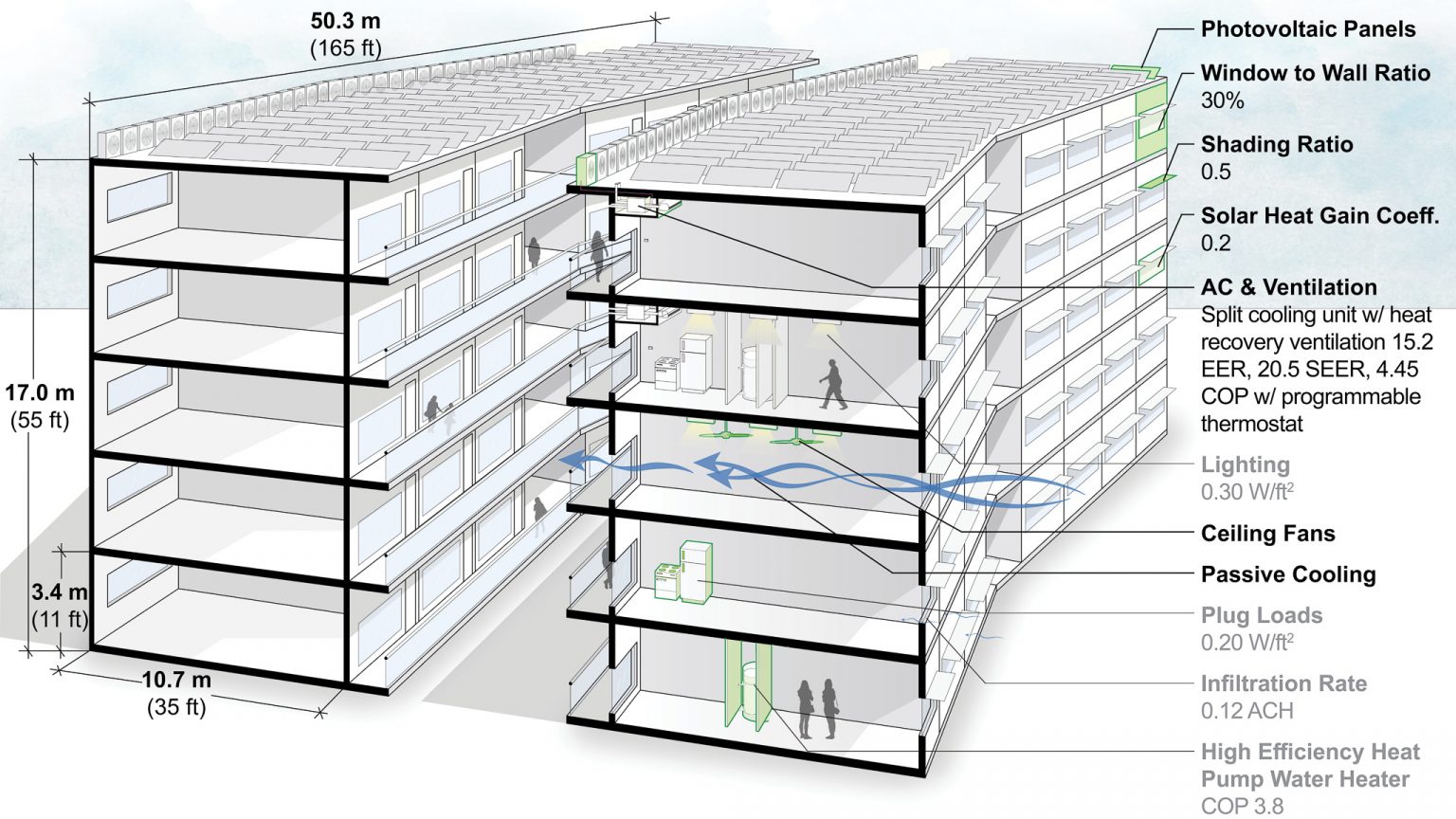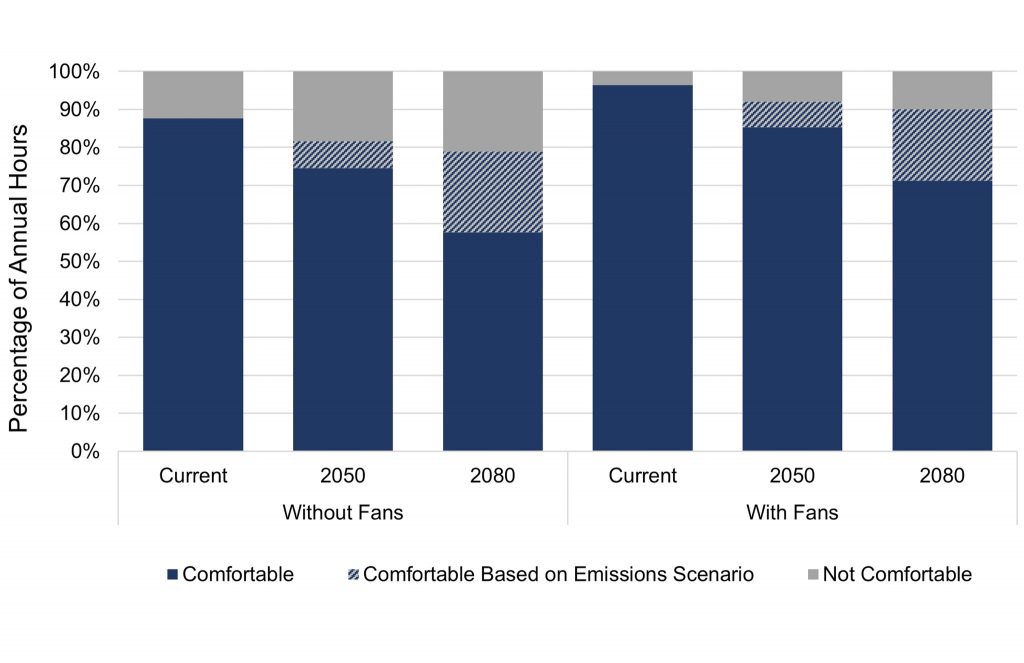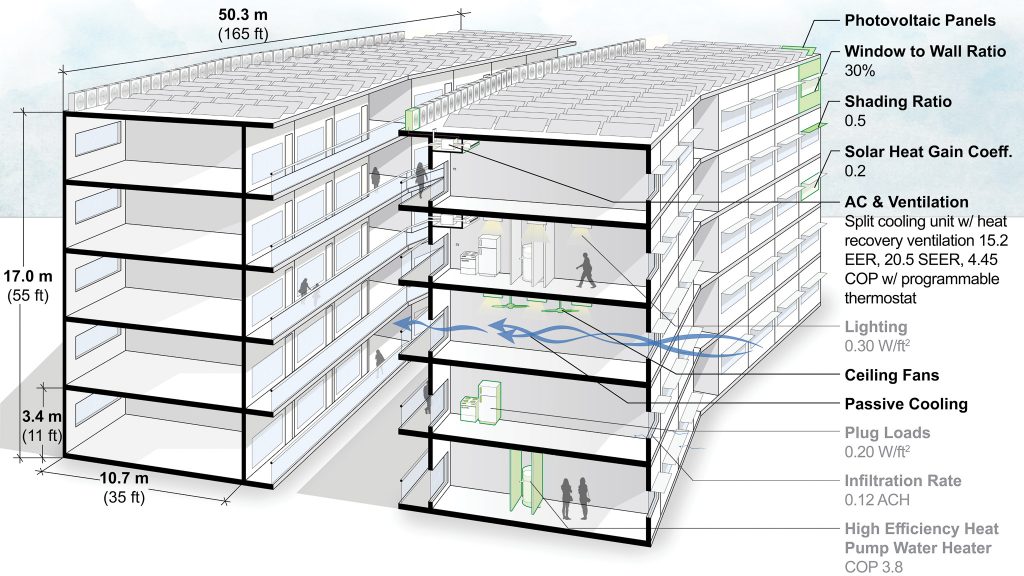
Research concerning the anticipated impact of future weather on energy consumption and thermal comfort in Hawai‘i’s typical multi-family housing was recently published in the Architectural Research Centers Consortium (ARCC) 2023 conference proceedings.
The paper “Estimating Thermal Comfort and Energy Use with Future Warmer Weather” is authored by UH Associate Professor Wendy Meguro; Building Performance Group Leader at CannonDesign Elliot J. Glassman (formerly with WSP); and UH Climate Adaptation Specialist Josephine Briones. The research demonstrates a method using whole-building energy modeling and future, hotter Honolulu weather files to: 1) simulate the negative impact on occupants’ thermal comfort in unconditioned multifamily buildings; 2) describe strategies designers may utilize now to promote future thermal comfort; and 3) quantify increased future energy use intensity with mixed mode operation. A team simulated a conceptual design for two multifamily five story residential buildings with an exterior walkway and 40 one-bedroom dwelling units per building (Image above). The findings on poorer thermal comfort negatively impact health and productivity, particularly for populations who cannot afford air conditioning. Increased air conditioning energy use impacts demand on the electrical grid, onsite renewable energy system sizing, and the ability to meet greenhouse gas emissions targets.
Using the TMY3 weather file, the unconditioned baseline multifamily building is estimated to be comfortable 88% of the time without fans, and 96% of the time with fans. The simulation estimates that the building will be significantly less comfortable in the future, as low as 75% of the time in 2050 and 58% of the time in 2080. Encouragingly, with fans, it is estimated to be comfortable 85–91% of the time in 2050 and 71–90% of the time in 2100.
In mixed mode operation, the building’s energy use intensity increases from approximately 90 kWh/m2/yr (29 kBtu/ft2/yr) today to approximately 107-132 kWh/m2/yr (34–42 kBtu/ft2/yr) in the year 2080. Although the research focuses on this specific building, the design strategy recommendations apply widely to future residential buildings in Honolulu and the process may be replicated for different building types.
The simulation estimates that the multifamily building in Honolulu, HI will be warmer and less comfortable in the future, but ceiling fans and design strategies to limit heat gain can help. While methods to model and present results of energy and thermal comfort with future weather are not standardized, this research demonstrates one approach with design guidance that may be applied today. Designers may take action now to prepare for future hotter temperatures through climate-appropriate building massing and orientation, exterior shading, glazing solar heat gain coefficient, limited glazed area, natural ventilation, and ceiling fans. These design strategies increase thermal comfort and help meet the State’s GHG emissions reduction targets by reducing the need for mechanical cooling. If mechanical cooling is installed in the future, the building’s energy use intensity increases, but may be lessened through inclusion of the aforementioned design strategies and occupant education on mixed mode operation.
Designers should plan for future addition of mechanical cooling in buildings and policymakers should implement policies to curb GHG emissions and reduce overheating in buildings.
This research was conducted through the UH School of Architecture’s Environmental Research and Design Lab as well as the Hawaii Sea Grant Center for Smart Building and Community Design. Funding was provided by the Office of Naval Research and the Hawaii Natural Energy Institute with resources from the State of Hawaii Energy Systems Special Fund §304A-C. In kind support was provided by the UH School of Architecture and Sea Grant College Program. Additionally, we thank team members Charles Chaloeicheep, Zachary Stevens, and Eileen Peppard, Aiko Tells, and Darlyn Chau.”
Read on UH News
Related Publications:
City and County of Honolulu Climate Change Commission: URBAN HEAT – GUIDANCE DOCUMENT– January 2024

“Percentage of annual hours that meet ASHRAE 55 adaptive thermal comfort model in the multifamily IECC baseline building without air conditioning in Honolulu, HI.”
